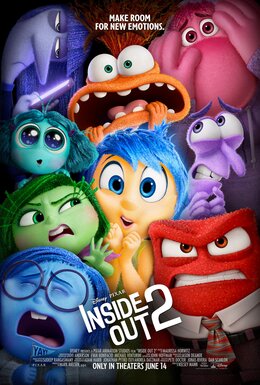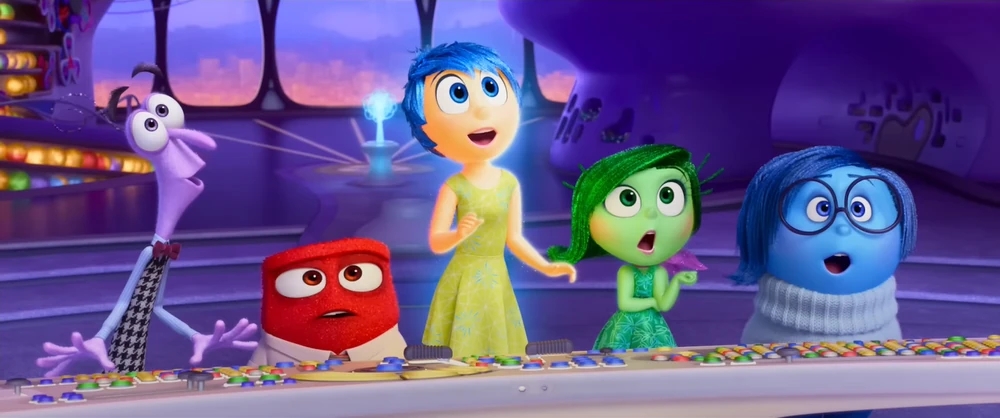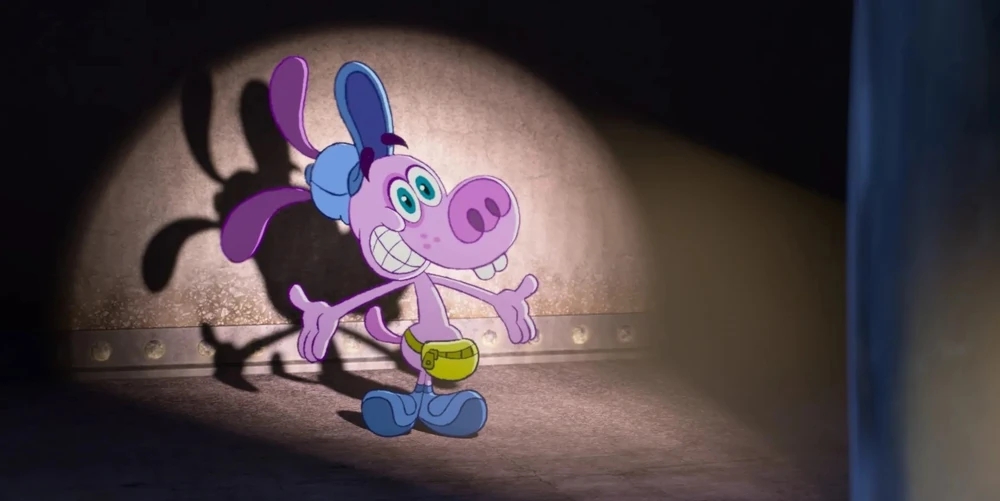*All reviews contain spoilers*
Disclaimer: This blog is purely recreational and not for profit. Any material, including images and/or video footage, is property of their respective companies, unless stated otherwise. The author claims no ownership of this material. The opinions expressed therein reflect those of the author and are not to be viewed as factual documentation.
Hello again everyone, and welcome to another review! After some of the recent comments from Pixar’s Pete Docter regarding the studio’s upcoming projects, I’m sure many of us are sharing the same uncertainties about its future. With a push to focus more on stories with broad appeal instead of more personal films, not to mention Walt Disney Animation’s firm focus on sequels for the foreseeable future, you do wonder if real creativity is under threat at the Mouse House. I have mixed feelings, personally, and am more interested in some of these (Moana 2, Zootopia 2) than others (Toy Story 5, Frozen 3 and 4), but it’s reassuring to know that there are still some original projects in the pipeline too, such as the delayed Elio. It remains to be seen how Disney’s next effort, the TV-show-turned-movie Moana 2, is going to fare when it arrives this November, but for now, let’s focus on Pixar’s newest offering – Inside Out 2.

I must say, of the many, many sequels on the Disney/Pixar slate, this was one of the few that actually made sense to me, feeling like a natural continuation of an open-ended story. The original Inside Out, directed by Pete Docter back before he became head of the studio, was one of the few bright spots in an increasingly mediocre line-up of post-Toy Story 3 Pixar films when it debuted in 2015. Now, nine years and one pandemic later, the studio’s situation is looking increasingly dire, so it’s encouraging to see that Inside Out 2 has gotten off to a strong start.
This time around, the adventures of Riley’s emotions were directed by Kelsey Mann in his feature directorial debut (Docter, presumably, had his hands full running the studio), with Meg LeFauve returning to co-write the story alongside him. LeFauve was also responsible once again for the screenplay, written this time in collaboration with Dave Holstein, while the score was provided by Andrea Datzman, who took over from Michael Giacchino and thus became Pixar’s first female composer.
Amy Poehler returns as Joy, the unofficial “leader” of Riley’s emotions. She is joined again by Phyllis Smith as the loveable Sadness, and Lewis Black as the irascible Anger. Diane Lane and Kyle MacLachlan also return as Riley’s parents, but there have been a few replacements this time around. Fear, formerly played by Bill Hader, is now voiced by Tony Hale, while Liza Lapira replaces Mindy Kaling as Disgust. Kensington Tallman also joins the cast as the new Riley, replacing Kaitlyn Dias (Kensington Tallman is a truly awesome name, props to her). The core crew are supported by new emotions Maya Hawke (Anxiety), Ayo Edebiri (Envy), Adèle Exarchopoulos (Ennui, another fabulous name there), and Paul Walter Hauser (Embarrassment), with Lilimar, Ron Funches, Yong Yea, James Austin Johnson and Steve Purcell also notable in minor but entertaining roles.
These casting changes were a point of controversy due to salary discrepancies. While Poehler accepted a cool $5 million offer to return as Joy (along with “lucrative bonuses”), the voices of the other four lead emotions were apparently offered a paltry $100,000 each – about two percent of Poehler’s salary. What the heck was that about? I mean, I get that Joy had more lines than the others in the first film, but what about Sadness/Phyllis Smith? Wasn’t her part big enough to warrant a higher sum? The rest of the emotions play a more equal role in this film, too, so this seems rather unfair. While Smith and Lewis Black agreed to reprise their roles in spite of this, Hader and Kaling declined; thankfully, the re-casting isn’t especially noticeable unless you’re looking for it (although Lapira makes a more seamless transition into Disgust than Hale does as Fear).

When it came to devising a story for Riley’s next outing, the team ran into several of the same issues that Docter’s had when creating the first one. Mann’s first draft had a whopping nine new emotions crammed into Riley’s head (still paling in comparison to Docter’s original twenty-seven), with the idea being that the poor girl would be overwhelmed by them all showing up at once. However, the writers realised that this also risked overwhelming the audience, so their numbers were cut back to help keep the story more focused. Among the cut emotions were Guilt and Jealousy, aspects of which were subsumed within Anxiety and Envy (Schadenfreude was also considered; i.e., feeling joy at someone else’s expense. Damn, that could have been amazing! I’d love to see Joy interacting with Schadenfreude… that could be the basis of a whole new sequel!).
It’s becoming increasingly common practice – and rightly so – for Disney/Pixar story teams to hire “brain trusts” of people with relevant experiences to help advise the writers when creating their stories, and Inside Out 2 was no exception. As funny as it sounds, Pixar actually worked with a group of nine teenagers – dubbed “Riley’s Crew” – to ensure the filmmakers were accurately portraying modern teenage life. (Perhaps trying to avoid the horrendously dated “How Do You Do, Fellow Kids?” tone of Ralph Breaks the Internet.) One thing I found especially interesting about their involvement was that their input led to the inclusion of an extra emotion, Nostalgia, who appears in a cameo role (arriving “too early”) played by 94-year-old June Squibb. It is perhaps a little sad to think that even teenagers, who should be looking forward to their futures, instead considered nostalgic longing for the past a key part of their experiences – a sign of the times, perhaps? Anyway, let’s not get bogged down in existentialism.
I’ll just get a few minor criticisms out of the way before we get to the good stuff. In my screening, I noticed that some of the younger kids in the audience were getting restless, chattering and crunching, with one kid in particular coming and going at least half a dozen times throughout the film. Pixar films have often been known to be more “challenging” than other family films and I do wonder whether the frenetic pacing of this one, coupled with the focus on experiences the little ones might be too young to relate to yet, prevented them from getting into it. Inside Out 2 really rockets along and is packed with dialogue – it felt like there was scarcely a moment where a character wasn’t talking at top speed, so the film never really gets a chance to breathe. That said, perhaps I’m just getting old; a pair of teenage girls just behind me seemed to relate to it just fine, judging from their giggling and whispering whenever Riley did something cringey.
There has also been some general criticism from audiences regarding the choice of emotions depicted, with some feeling that emotions like envy, embarrassment or even anxiety could come under the umbrella of fear and therefore didn’t need to be depicted as separate beings; perhaps the writers could instead have tried to further develop the existing characters? It has to be said that of the four new emotions introduced (or five, if you count little old nostalgia), only Anxiety is really given much to do. Envy feels especially underutilised, serving as little more than a foil for Anxiety to interact with – the other two being, by their nature, less interactive.
Those quibbles aside, however, I’m pleased to say that I had a great time with this one and would even put it on a par with the original, a rare feat for sequels. I had not started my blog yet when the first Inside Out arrived in 2015 and, given the dismal collapse of my Pixar season project (I swear I’ll get that Incredibles review out someday, if it’s the last thing I do), I’ve never had an opportunity to express my thoughts on it. When considering the 2010s Pixar films, I’d give it a solid third place behind Toy Story 3 and Coco, as like many fans I consider it one of the few highlights from an otherwise unimpressive decade. Inside Out was a simple, moving and smartly written ode to adolescence, championing emotional intelligence and mental health in a way that few other family films had up to that point. The minimalistic cast kept tight focus on the interplay of the different emotions without ever demonising any of them, with that final, heart-warming reunion encouraging a new generation of kids to communicate with their parents. Warm, cosy and charming, Inside Out has earned a place for itself as a firm fan favourite, so it was no surprise to see the story continued – and, in this case, it felt justified.
Inside Out 2 picks up about a year after the end of the last film, with Riley now a young teenager on the brink of the dreaded puberty (a development that was hinted at in the last film’s closing scenes). As new emotional complexity dawns, Riley’s headquarters suddenly becomes a lot more crowded, and Joy – who has thankfully retained the growth she underwent last time – must once again grapple with being displaced as the dominant emotion. Gone are the days when Riley could be guided solely by happiness, safe in a comfortable childhood; now, with new experiences and new challenges around every corner, Joy must deal with the fact that Riley’s needs are becoming much more complicated. However, with the over-eager Anxiety at the helm, charting a course for Riley through these uncharted waters will be anything but smooth sailing.

There’s quite a bit of new “architecture” introduced in this film, but my favourite of the new ideas was that Riley has begun gradually developing a sense of self rooted in her beliefs, which are in turn created through her experiences. It feels true to life as she matures towards adulthood and detaches her identity from that of her parents, with her developing personality no longer fitting into the simplistic, one-emotion-at-a-time framework she’s been used to. Of course, Joy is still Joy, so although she has learned to embrace the contributions of her fellow emotions (even Sadness), she has still been unable to resist meddling in Riley’s development. We learn that she has been suppressing Riley’s more unpleasant memories and building her sense of self out of only the positive ones, an act which seems kind on the surface, but is actually hindering Riley’s growth into a well-rounded individual. The darker sides of Riley are just as much a part of her as everything else, something Joy will be forced to acknowledge before the film is through.
As far as the new emotions go, Anxiety is easily the highlight, although that’s not to say the other three don’t play their part. Anxiety feels like a classic Pixar antagonist, creating obstacles for both Joy and Riley without ever feeling like a villain – the road to hell, and all that. Much like Puss in Boots: The Last Wish did a couple of years back, Inside Out 2 features a realistic depiction of an anxiety attack as the crux of its emotional climax, and it’s wonderful to see major studios like this teaching young audiences healthy ways to handle them. While a Hollywood blockbuster should obviously never be one’s first source of information, it’s still nice to see such media being used to educate wherever possible; Inside Out 2 follows Turning Red’s example by teaching its viewers a little something about themselves even as it entertains.

Interestingly, Anxiety seems to go through a similar character arc to Joy’s from the first film, with her good intentions and suppression of all other emotions preventing her from recognising the harm she’s doing until it’s almost too late. Joy’s past experience allows her to empathise with Anxiety – after some initial frustration, of course – and she’s able to teach the newbie how to step back, let go and stop micromanaging Riley by herself, working with the others instead of against them to properly guide Riley through the confusion of adolescence.

Of course, as with any sequel, it’s the original characters we’re really here to see, and I’m pleased to say that the core five get more equal roles this time around. The nature of the first film’s story put the focus on the binary dynamic between Joy and Sadness, but this necessitated leaving the other three in the background. Here, Fear and Disgust in particular play much bigger roles (thank goodness the re-casting wasn’t too jarring), but the whole group feels much more cohesive and united than they did last time. If anything, it’s the trio of Ennui, Envy and Embarrassment who get the shaft in this one, so perhaps a third instalment will give them more time to shine… while also introducing yet more emotions to simmer in the background, I’m sure. Such is the nature of growing up, I suppose!

On Riley’s side of things, I appreciated the subtle variation on the standard peer pressure storyline so common to teen-centric stories like this, as it felt like a more realistic take on the situation. Rather than facing overt bullying or being pushed into drugs right out of the gate, the conflict is mostly internal, with the “cool girls” Riley meets at hockey camp representing the ideal that Riley so desperately wants to mould herself into. Unfortunately, Riley makes the all-too-real mistake of trying to literally become her idols, sacrificing every little “outdated” or “unfashionable” thing about her true self in her quest to grow up as fast as possible. The films shows us the inner turmoil this creates within her, as her actions stray further and further from her sense of self and thus feed her insecurities, with Anxiety frantically trying to control the damage she’s done until we build into the climactic panic attack. So many films before this have championed the message “just be yourself”, but I’ve never seen one articulate what that really means so well before.

Oh, yes, and one more thing – I CANNOT OVERSTATE how much I loved the mix of animation styles present in this film, something we also saw to some degree in the first one. To see Pixar, that bastion of computer animation, dabbling in traditional 2D artwork, just gives me so much hope (queue crying Katara) … But seriously. The Inside Out films seem to be unique for Pixar in this regard (excepting, perhaps, a small amount of 2D animation here and there in films like Coco), but I’d love to see a greater variety of styles and aesthetics like this introduced into future projects. I won’t spoil exactly where it’s used, but suffice to say that it adds greatly to the characters and the scenes that have it.
If you’re on the fence about seeing this one, then please let me encourage you to give it a chance. Along with Turning Red, I feel comfortable in saying this is one of the best Pixar films we’ve had post-Coco. While it may still fall a little short of the lofty bar set by the classics (and we really must get out of the habit of comparing everything they make with those), it has a lot to offer for fans and works well as a new chapter in a single continuous story. Also, I really wish I’d stayed right to the end for the post-credits scene, but I hadn’t realised there was going to be one! You feel such pressure to leave when the theatre isn’t very full…
Anyway, thank you so much for reading, and I hope you’ve enjoyed this review. There probably won’t be another First Thoughts entry for a while as there’s not a great deal coming out this year that interests me (I’ve not seen a DreamWorks film in theatres for ages, not being much of a Kung Fu Panda fan), but of course, there will still be plenty of book reviews to keep us going! Until next time, take care and staaay animated!
References
By http://www.impawards.com/2024/inside_out_two_ver2.html, Fair use, https://en.wikipedia.org/w/index.php?curid=75269099 – credit for poster
https://disney.fandom.com/wiki/Inside_Out_2/Gallery#Screenshots – credit for other images
https://en.wikipedia.org/wiki/Inside_Out_2 – Wiki page
https://www.imdb.com/title/tt22022452/ – IMDb profile

